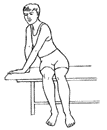Neurodiversity information for parents and young people
About postural hypotension
Postural hypotension is a fall in blood pressure which often occurs when a person changes their body position (posture), typically from lying to standing or sometimes sitting to standing.
It is a common problem affecting older people but it can affect younger people too.
Causes
There are many causes of postural hypotension, such as:
- not drinking enough fluids and becoming dehydrated
- overheating – after a hot bath, being in a hot room or on a sunny day
- illness like cold or infections
- anxiety or panic – this can cause you to change your normal breathing pattern
- anaemia (lack of enough red blood cells to carry adequate oxygen to your body’s tissues)
- mobilising after a period of prolonged bed rest
- conditions affecting the nervous or endocrine system, such as Parkinson’s disease, diabetes, Addison’s disease
- certain medications
- taking too many ‘water tablets’ (diuretics) can cause you to become dry or dehydrated
- too much medication for high blood pressure (anti-hypertensives)
- medication for specific diseases or conditions – for example, Parkinson’s Disease.
Do not adjust your medication without consulting your doctor.
Symptoms
Symptoms can vary from person to person and may include:
- feeling dizzy or light-headed
- feeling confused
- losing consciousness with or without warning, a ‘faint’ or ‘blackout’
- changes in your vision such as blurring, greying, or blackening vision
- weakness and fatigue
- pain across the back of your shoulders and neck
- pain across your lower back and buttocks.
Symptoms are more likely:
- when moving – standing or sitting up suddenly
- in the morning – blood pressure is naturally lower first thing in the morning
- during exercise – exercise and activity of any kind (including housework) increases your muscles’ demand for blood
- after meals – blood is needed by the digestive system, particularly after meals (blood is diverted to the digestive system particularly after a large meal or alcohol)
- straining – if you are constipated or are having difficulty passing urine.
Reducing symptoms
There are lots of things to do that may help reduce symptoms.
Things to avoid
- Dehydration. Try to drink 3 ½ pints (2 litres) of fluid (for example, tea, coffee, water, juice, milk), every day. If you have a heart condition or kidney problem or if you have been told to limit your fluid intake for any other reason, ask your doctor how much you should drink.
- Getting up quickly or rushing.
- Standing/sitting still for long periods of time.
- Bending at the waist or stretching up if possible. If you drop something on the floor, squat with your knees to recover it.
- Excessive alcohol.
- Large, starchy meals (bread, potatoes, rice, pasta).
- Overheating, for example, having very hot baths or getting over heated in a very warm room.
- Constipation. Ensure that your diet is high in fibre.
Things to do
-
Sleep with your head raised 5 inches above the level of the mattress.
-
Have 1 to 2 glasses of water (or dilute liquids) nearby and drink them before you stand up.
-
Plan your day ahead and sit down for tasks such as preparing meals and getting dressed.
Movements to try
| Move your ankles up and down and squeeze your buttocks before moving from lying to sitting. |  |
| Rise slowly when getting out of bed. Sit with your legs hanging down for a few minutes before standing. Make sure that your balance is steady before walking. |  |
| Stand or get up slowly, especially after sleeping or sitting down for a long period. Try marching your legs up and down briskly before standing. |  |
Other recommendations
Ask your doctor or pharmacist if any new medication you are taking is likely to affect your blood pressure.
Postural hypotension can make you more prone to falls. You can ask your doctor to assess your bone health as you may benefit from medication which can strengthen your bones.
If you get symptoms
Think of the symptoms as a warning that your blood pressure is too low. The way to improve your symptoms and maintain your safety is to:
- Stop what you are doing.
- Sit down or lie down until symptoms pass.
Pump your ankles, squeeze your buttocks, and try to raise your legs on a pillow or cushion if possible.
Have a means of getting help if you are unable to get off the floor yourself. For example, carry a mobile phone or a falls alarm.
Keep water and a blanket at floor level. - Drink a glass of water.
- Think about what could have triggered your symptoms.
Contact your GP for further advice if you have frequent symptoms. They may offer you further investigations of your symptoms, including medication review and lying and standing blood pressure monitoring.
Warning
Do not stop taking any medication without discussing this first with your doctor.
Treatment
Your treatment options will depend on what is causing the problems, but some of the options that may be offered are:
- medicines review and, if necessary, limiting or dividing the doses of certain medications
- leg compression stockings
- tablets to increase your blood pressure and avoid salt loss.
Contact information
See your GP if you have any questions or concerns.